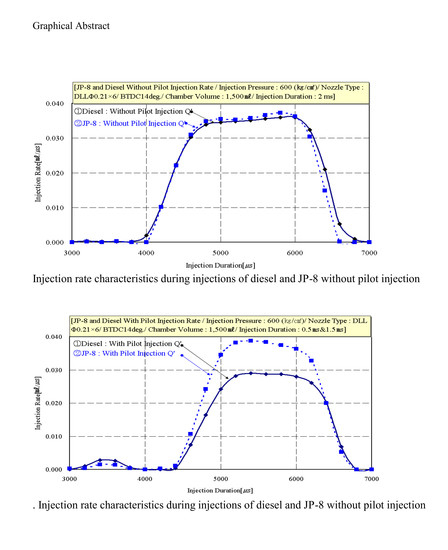A Study of Spill Control Characteristics of JP-8 and Conventional Diesel Fuel with a Common Rail Direct Injection System
Abstract
:1. Introduction
2. Experiment Equipment and Methods
2.1. Experiment Equipment
2.1.1. JP-8 Aviation Fuel Characteristics
2.1.2. Aviation Fuel Supply System
2.1.3. Common Rail Injector
2.1.4. Common Rail Control System
2.2. Experiment Method
Experiment Conditions and Measuring Methods
3. Experiment Results and Discussions
3.1. Pilot and Main Injection Quantities with Different Injection Times
3.1.1. Two-Way Valve (TWV) Driving Pulse
3.1.2. Rail Pressure
3.1.3. Needle Lift
3.1.4. Injection Rate
3.1.5. Injection Quantity and Spill Injection Quantity
3.2. Pilot and Main Injection Quantities According to Engine Revolution
3.2.1. Injection Quantity without Pilot Injection
3.2.2. Injection Quantity with Pilot Injection
4. Conclusions
- (1)
- JP-8 has a lower value than the diesel fuel’s (DF-1) required minimum kinematic viscosity of 1.3 cSt/40 °C (DF-2’s average kinematic viscosity is 2.73–2.8 cSt/40 °C), and there is the possibility that the common rail pump and injector’s friction points will become stuck.
- (2)
- Pressure pulses, which occur owing to pressure waves caused by injection, are a major cause of changes in the injection rate, and they can have a great impact on engine performance; thus, they should be reduced as much as possible.
- (3)
- For the same injection period, the diesel fuel needle lift gap is 0.325 mm and 0.35 mm for JP-8; this means that JP-8, which has a lower density, requires more injection time than diesel fuel.
- (4)
- The injection rate of JP-8 is higher than that of diesel fuel; thus, under fixed torque conditions, the amount of JP-8 consumed per unit of time is expected to be higher than that of diesel fuel.
- (5)
- When used in a diesel engine with an electronic common rail and without pilot injection, JP-8 has a similar low amount of heat to that of diesel fuel; thus, there is a possibility of increasing engine power without unsafe combustion.
- (6)
- The difference in spilling between diesel and JP-8 aviation fuel is greater than the difference in the injection amount per time. It is expected that in the process of controlling the injector solenoid through ECU and EDU, the oil pressure valve and the needle valve operate to a higher extent in order to maintain the diesel fuel’s injection quantity volume.
Acknowledgments
Author Contributions
Conflicts of Interest
References
- Kurman, M.; Bravo, L.; Kweon, C. The effect of fuel nozzle configuration on JP-8 sprays at diesel engine conditions. In Proceedings of the ILASS Americas 26th Annual Conference on Liquid Atomization and Spray Systems, Portland, OR, USA, 5–8 May 2014. [Google Scholar]
- Papagiannakis, R.; Kotsiopoulos, P.; Hountalas, D.; Yfantis, E. Single Fuel Research Program Comparative Results of the Use of JP-8 Aviation Fuel Versus Diesel Fuel on a Direct Injection and Indirect Injection Diesel Engine; SAE Technical Paper; 2006-01-1673; SAE: Warrendale, PA, USA, 2006. [Google Scholar]
- Lee, C. An experimental study on advanced injection rate measurement of a marine engine using the Zeuch method. J. Therm. Sci. Technol. 2016, 11, JTST0026. [Google Scholar] [CrossRef]
- Yu, J.; Lee, J.; Bae, C.S. Diemethyl Ether(DME) Spray Characteristics in Common Rail High Presure Injection Equipment; ISAF XIV Technical Papers; 2002-VT-10; ISAF: Kabul, Afghanistan, 2002. [Google Scholar]
- Benajes, J.; Pastor, J.V.; Payri, R.; Plazas, A.H. Analysis of the influence of diesel nozzle geometry in the injection rate characteristics. J. Fluids Eng. 2004, 126, 63–71. [Google Scholar] [CrossRef]
- Forester, D.R.; Malik, B.B.; Taylor, S.E. Jet fuel thermal stability-lab testing for JP8+100. In Proceedings of the International Spring Fuels & Lubricants Meeting & Exhibition, Reno, NV, USA, 6–9 May 2002. SAE2002011650. [Google Scholar]
- Gonzalez, C.; Jesik, R.L. The Multi-Fuel General Aviation Piston Engine; SAE Technical Paper; 2000-01-1714; SAE: Warrendale, PA, USA, 2000. [Google Scholar]
- Kato, N.; Moritsugu, M.; Shimura, T.; Matsui, J. Piston Temperature Measuring Technology Using Electromagnetic Induction; SAE Paper; 2001-01-2027; SAE: Warrendale, PA, USA, 2001. [Google Scholar]
- Boehner, W.; Hummel, K. Common Rail Injection System for Commercial Diesel Vehicles; SAE Paper; No. 970345; SAE: Warrendale, PA, USA, 1997. [Google Scholar]
- Diesel EMS and Injection Engineering Department. ECD-U2 System Operation Manual (for Rir Test & Engine Test); DENSO Co.: Kariya, Japan, 1996. [Google Scholar]
- Kim, Y.; Ayusawa, T.; Takishita, T.; Koo, Y.; Iwai, N. What is the potential of alcohol fuel-stratified charge engine for advanced power plant. In Proceedings of the First International Automotive Fuel Economy Research Conference, Arlington, VA, USA, 31 October–2 November 1996. [Google Scholar]




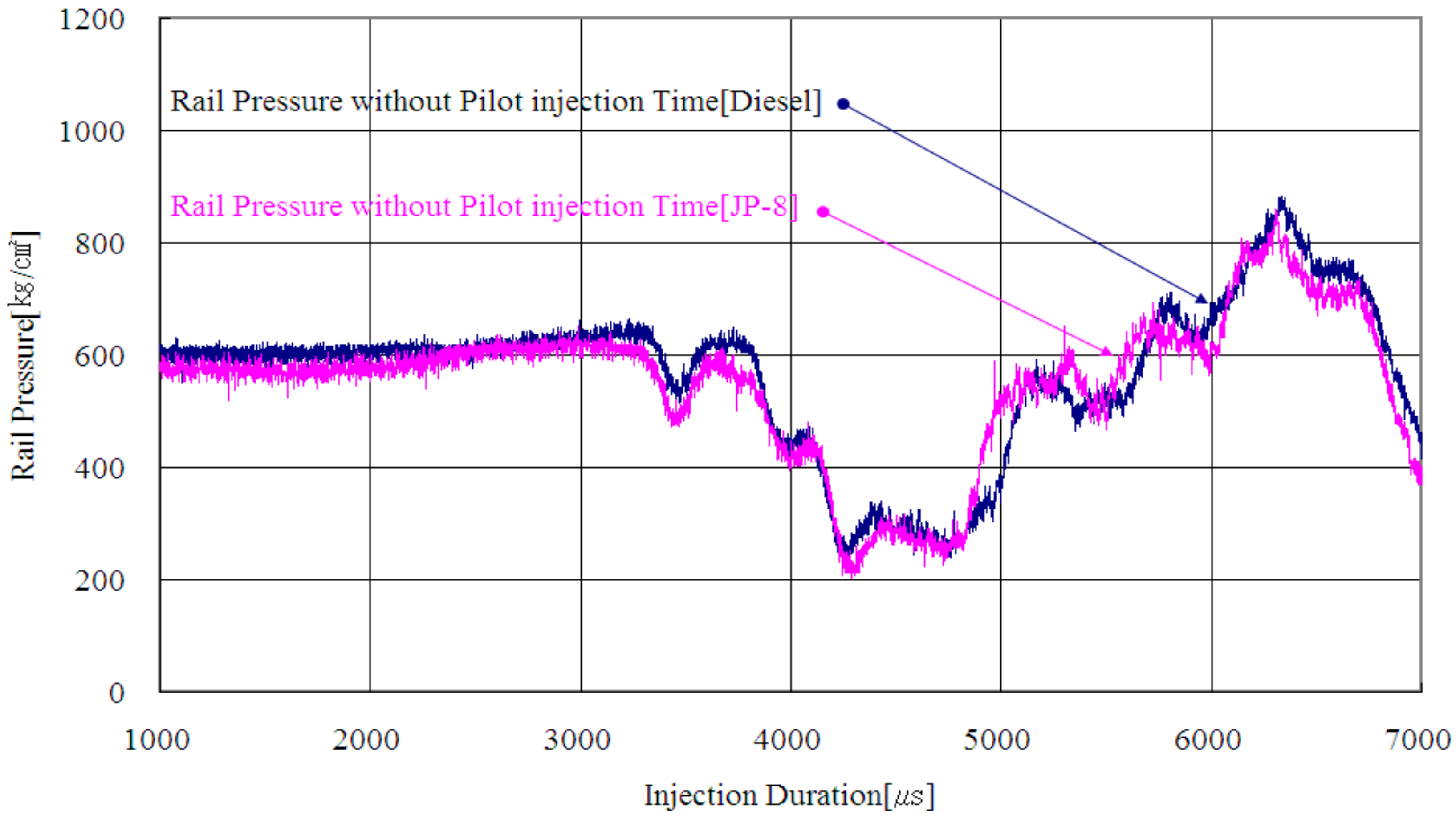
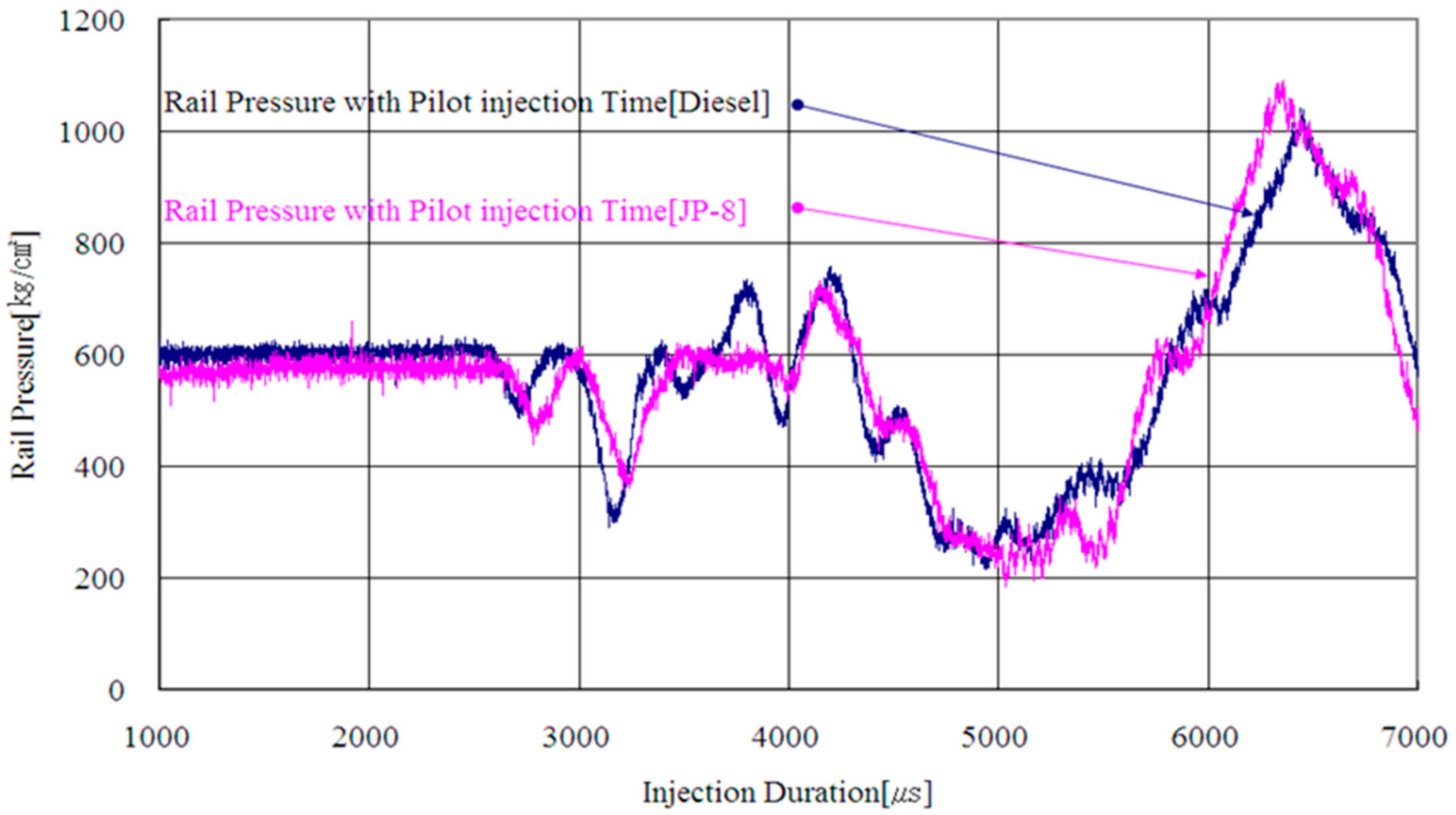
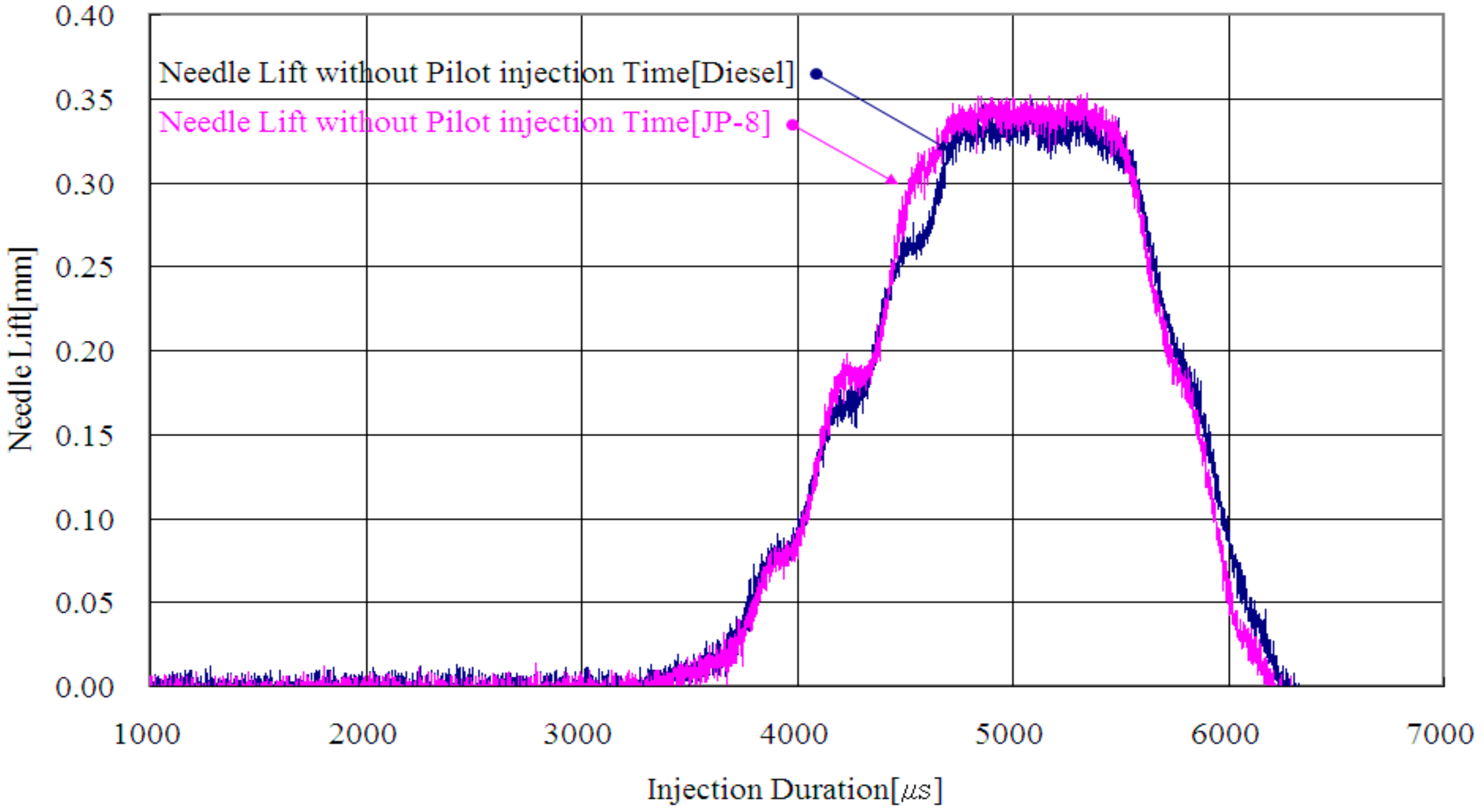
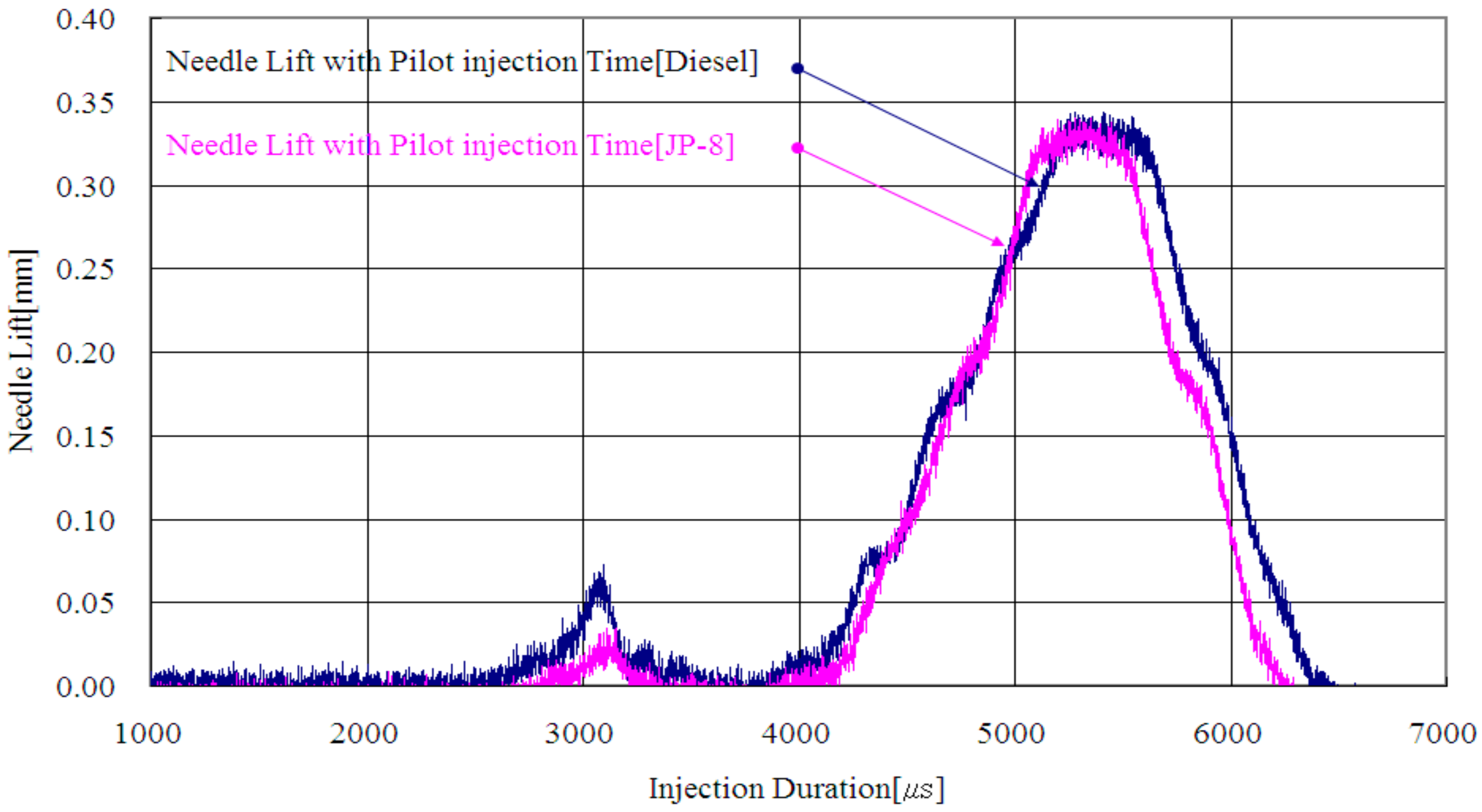

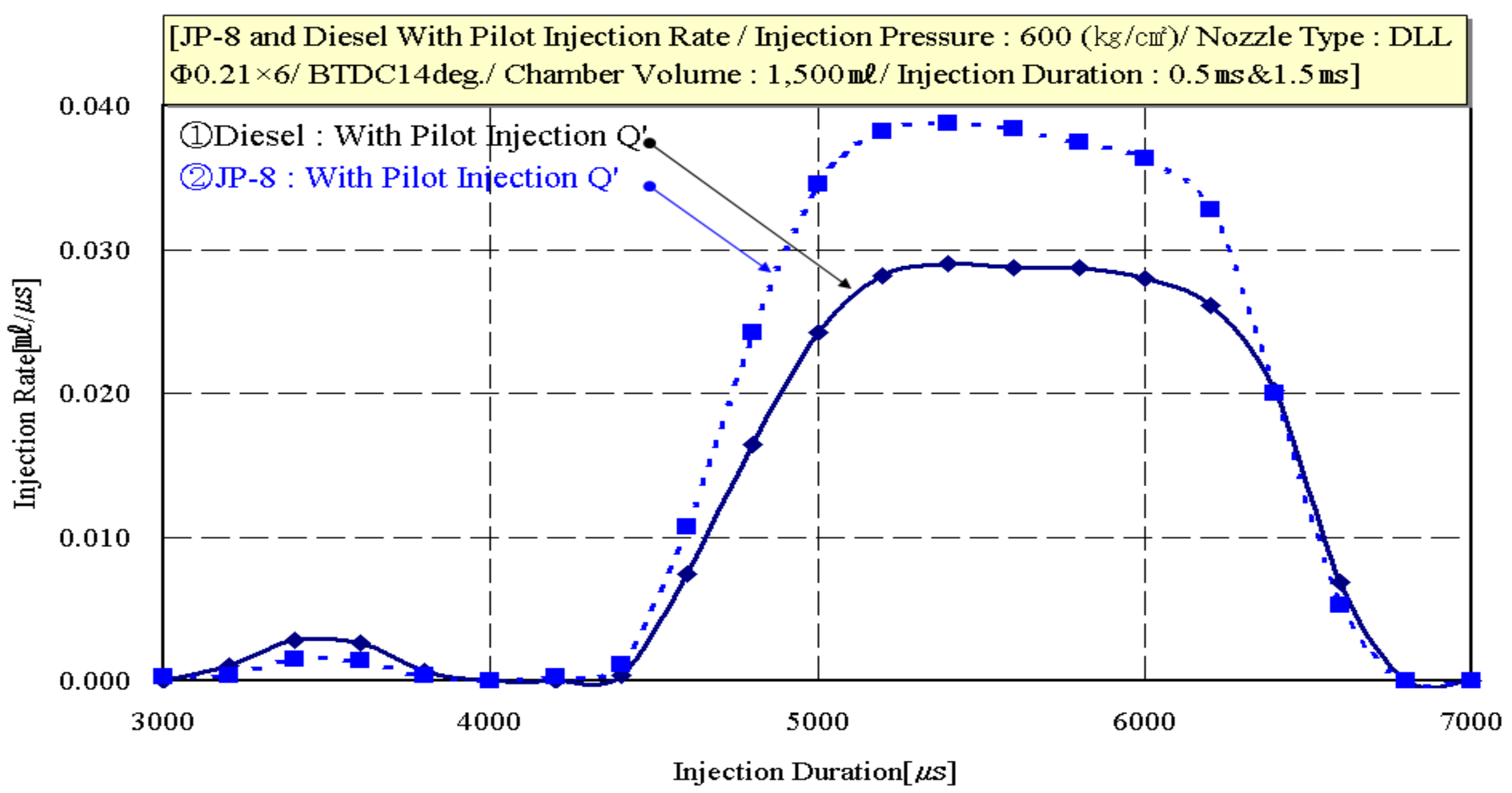
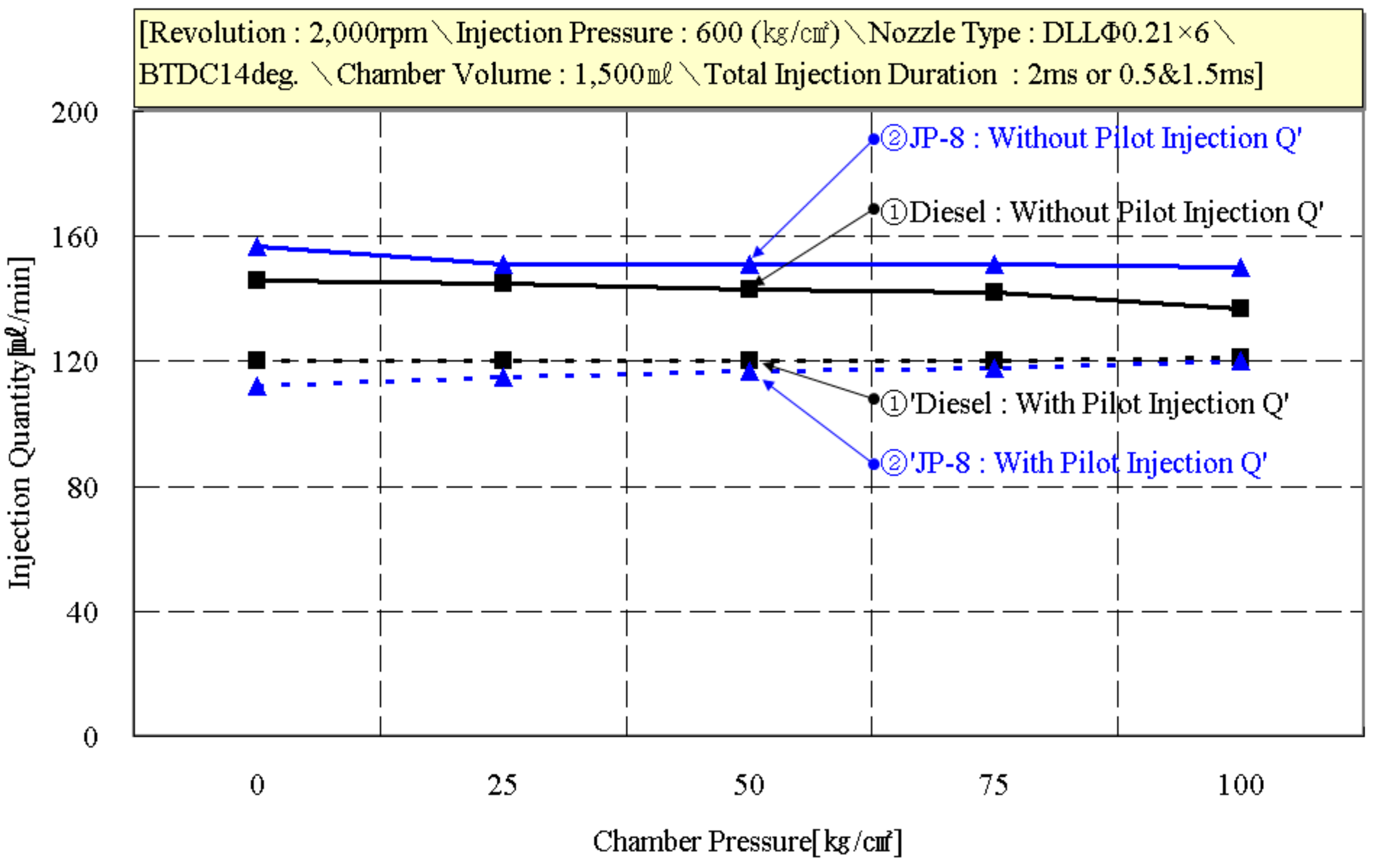
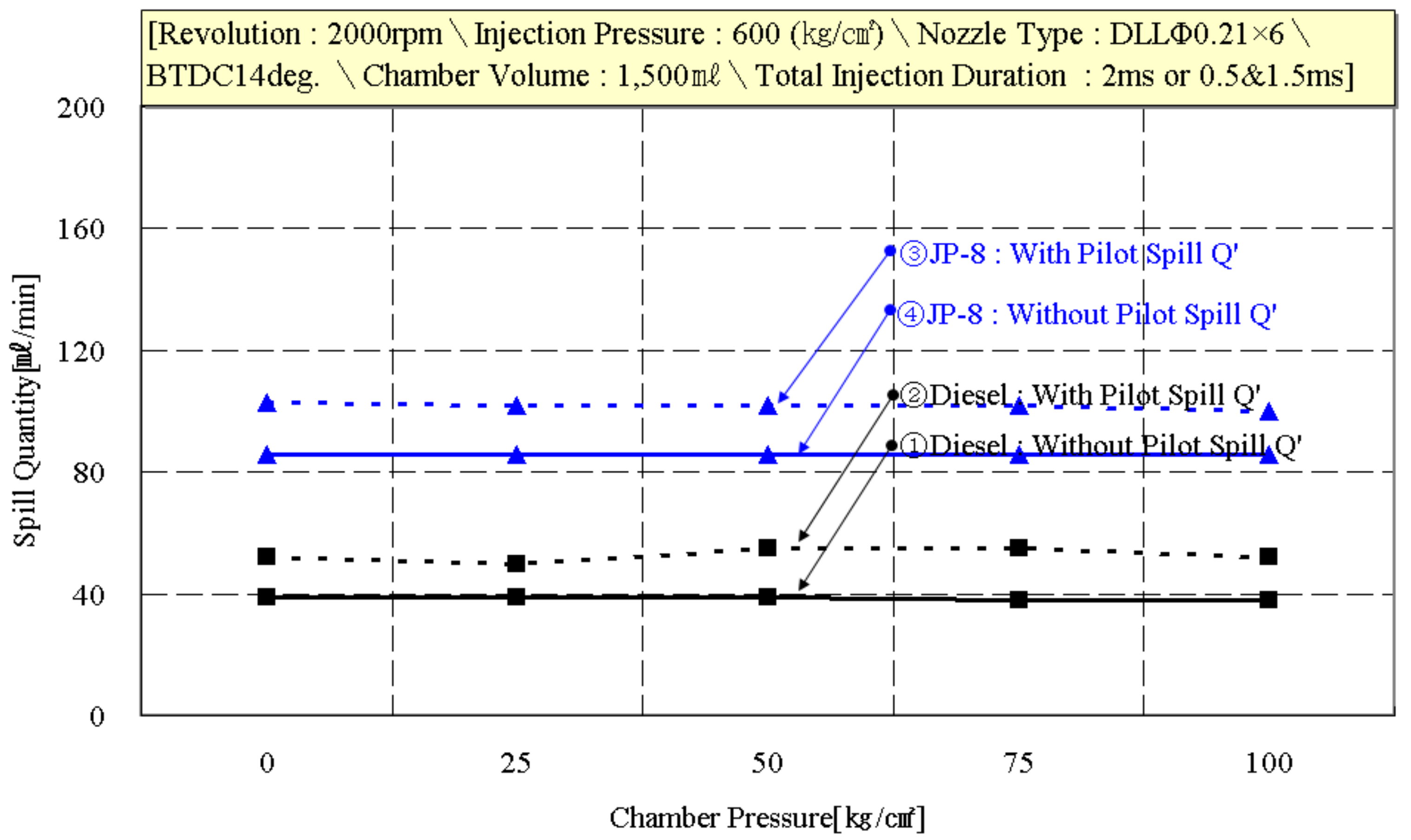
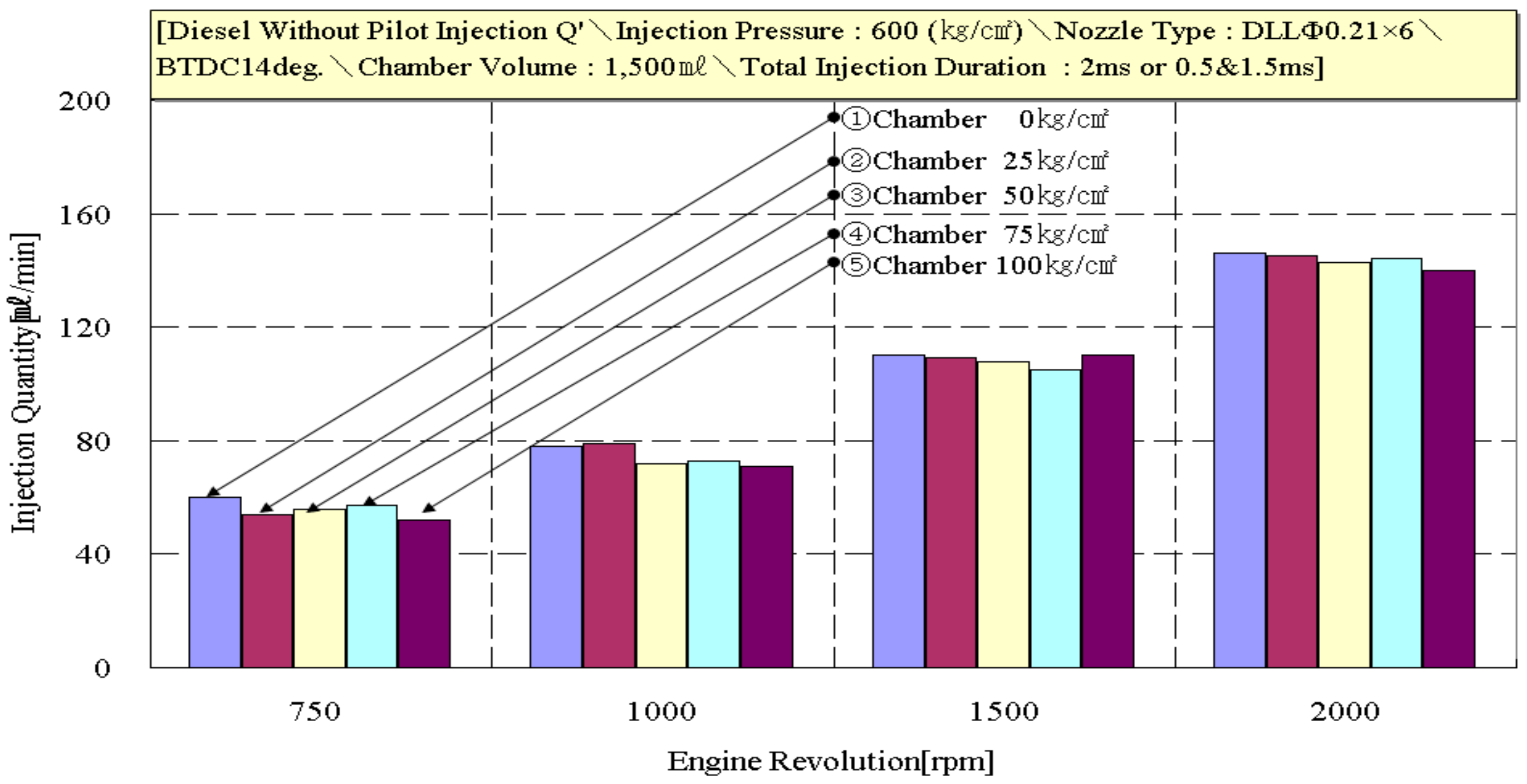
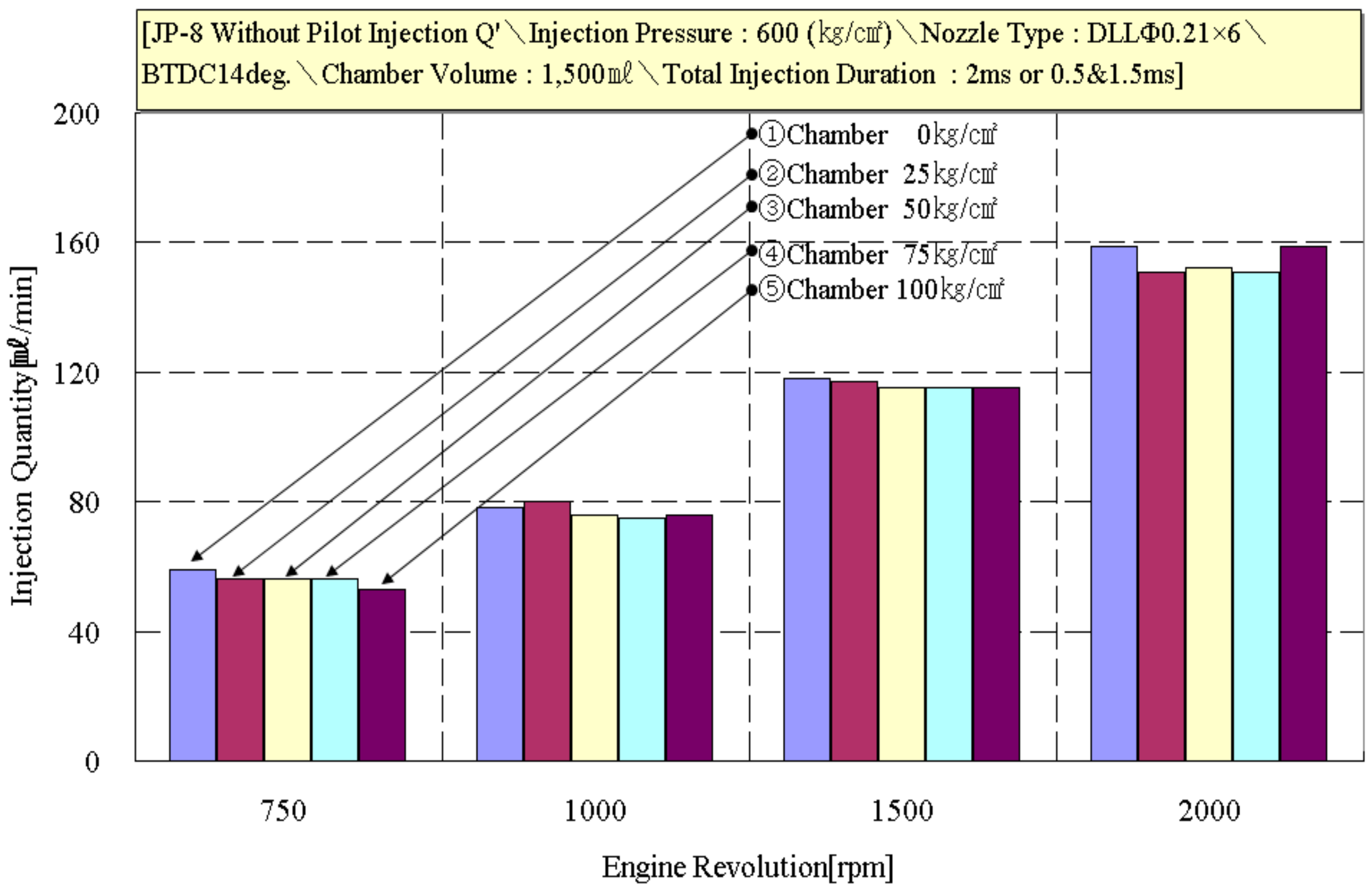
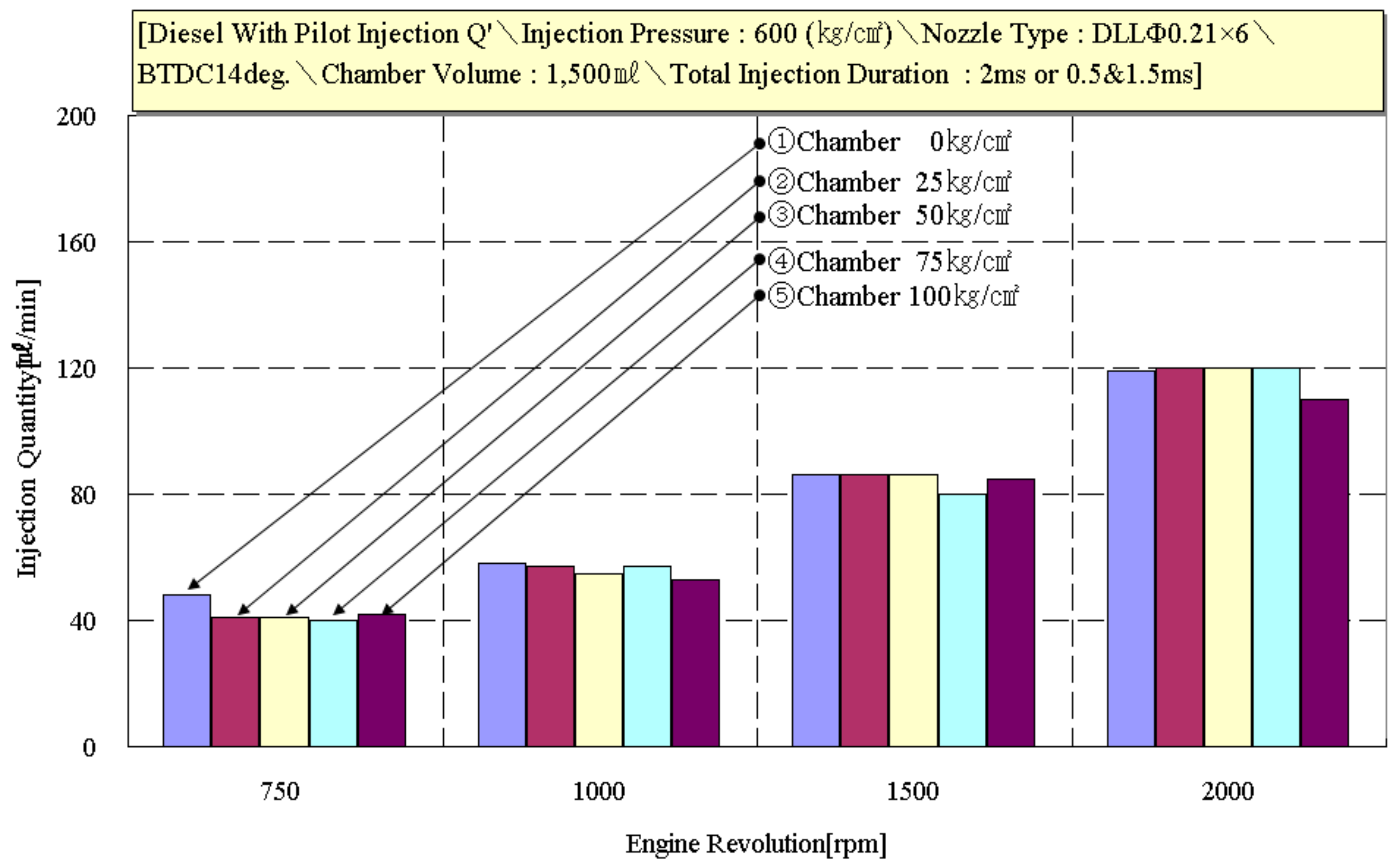
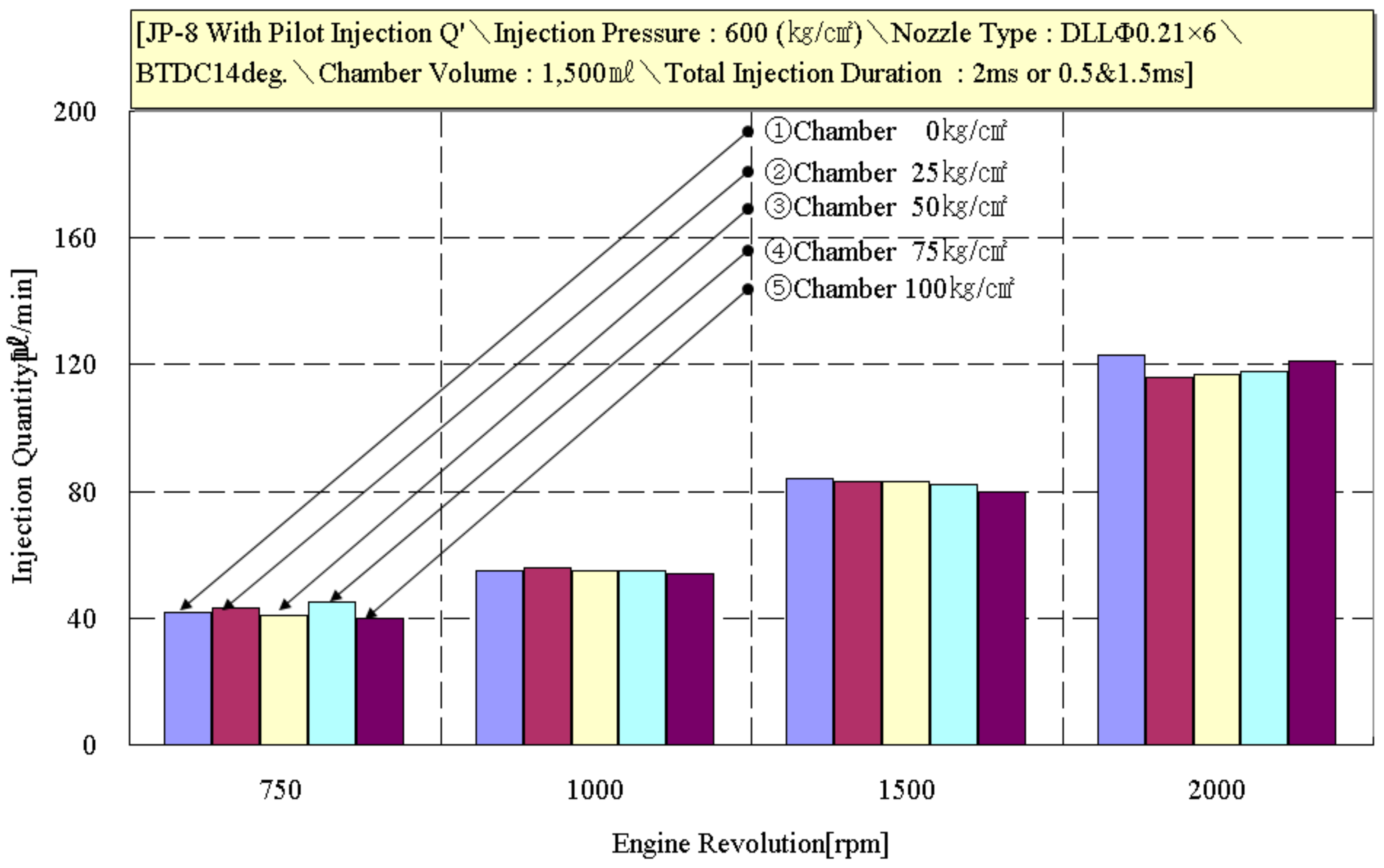
| Division | Unit | DF-2 (ASTM 2D) | JP-8 |
|---|---|---|---|
| T10 | °C | 226 | 170 |
| T90 | °C | 303 | 240 |
| T100 | °C | 326 | 266 |
| Cetane index | - | 47 | 39 |
| Cetane number | - | 46 | 38 |
| Low heating value | MJ/kg | 43.796 | 43.228 |
| Density at 15 °C | Kg/m3 | 847 | 812 |
| Aromatics | Vol. % | 33.8 | 11.0 |
| H2 | Mass % | 12.99 | 13.9 |
| Sulfur | ppm | - | 4 |
| Kin. Visc. (−20 °C) | mm2/s | - | 4.465 |
| Kin. Visc. (40 °C) | mm2/s | 2.86 | ~1.4 |
| Freeze point | °C | - | −57 |
| Flash point | °C | 78 | 47 |
| Items | Spec. | ||
|---|---|---|---|
| Injector | Max. Injection quantity (mm3/st) | 35 | |
| Max. Pressure (MPa) | 8.6 | ||
| Valve | Lift (µm) | 35–40 | |
| Nozzle | Open pressure (MPa) | 8.6 | |
| Needle lift (mm), (0.36 mm ⇒ Change) | 0.14–0.36 | ||
| Sack hole type | Mini sack | ||
| Seat diameter (mm) | φ1.9 | ||
| Injection hole (mm), (0.18 mm ⇒ Change) | φ0.21 × 5 | ||
© 2017 by the authors. Licensee MDPI, Basel, Switzerland. This article is an open access article distributed under the terms and conditions of the Creative Commons Attribution (CC BY) license (http://creativecommons.org/licenses/by/4.0/).
Share and Cite
Yang, S.; Moon, H.; Lee, C. A Study of Spill Control Characteristics of JP-8 and Conventional Diesel Fuel with a Common Rail Direct Injection System. Energies 2017, 10, 2104. https://doi.org/10.3390/en10122104
Yang S, Moon H, Lee C. A Study of Spill Control Characteristics of JP-8 and Conventional Diesel Fuel with a Common Rail Direct Injection System. Energies. 2017; 10(12):2104. https://doi.org/10.3390/en10122104
Chicago/Turabian StyleYang, Seomoon, Hoonyoung Moon, and Changhee Lee. 2017. "A Study of Spill Control Characteristics of JP-8 and Conventional Diesel Fuel with a Common Rail Direct Injection System" Energies 10, no. 12: 2104. https://doi.org/10.3390/en10122104
APA StyleYang, S., Moon, H., & Lee, C. (2017). A Study of Spill Control Characteristics of JP-8 and Conventional Diesel Fuel with a Common Rail Direct Injection System. Energies, 10(12), 2104. https://doi.org/10.3390/en10122104




